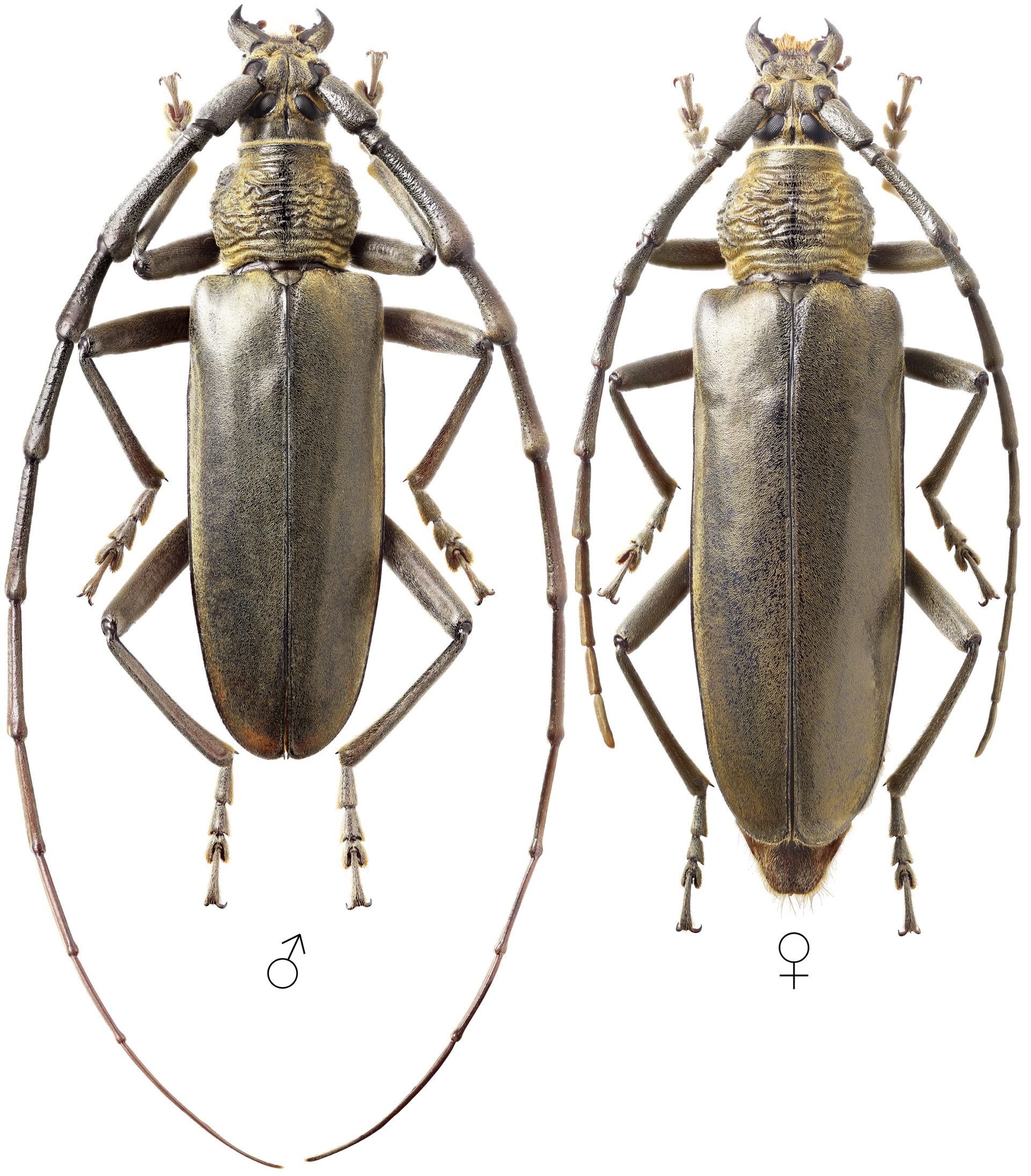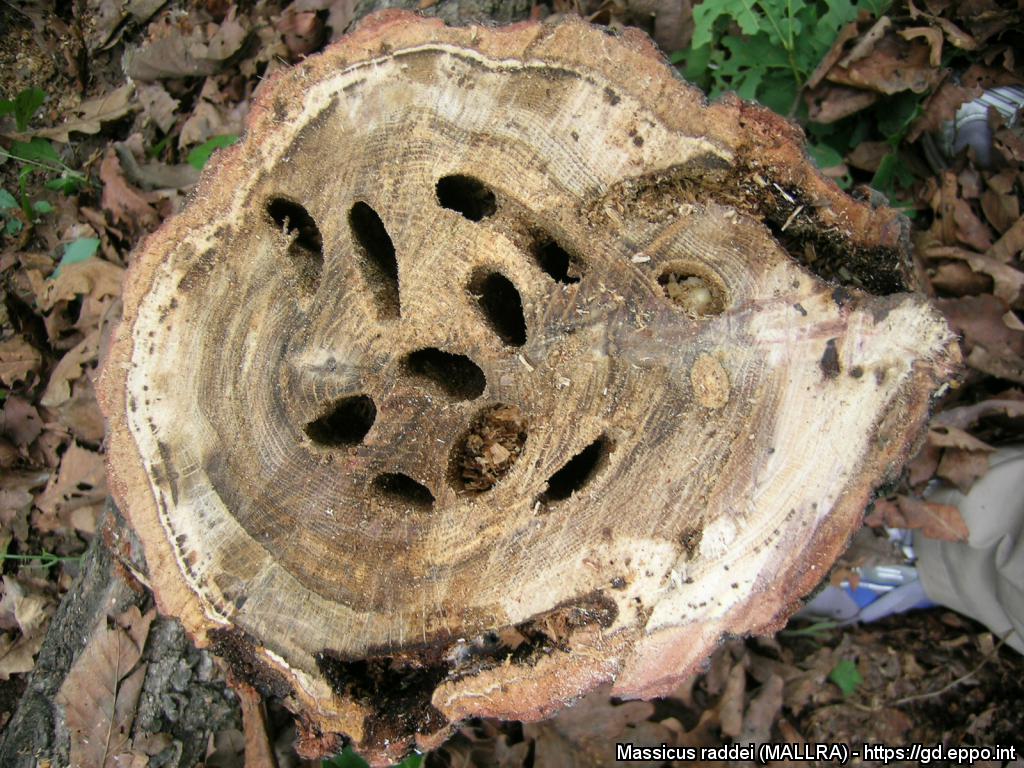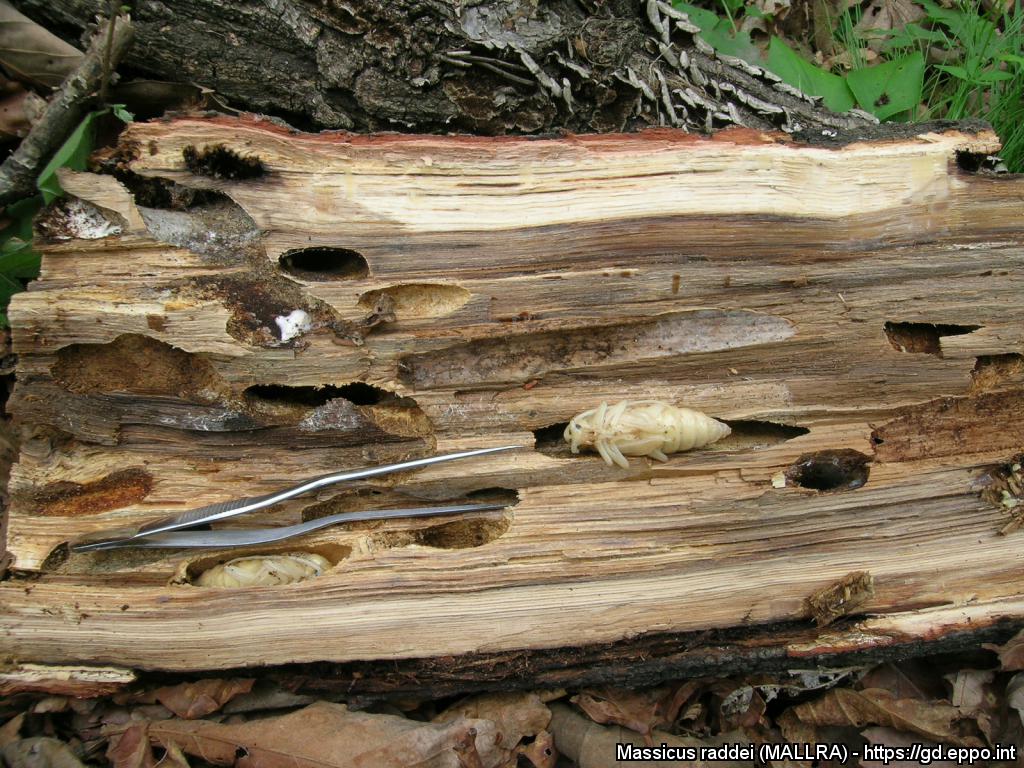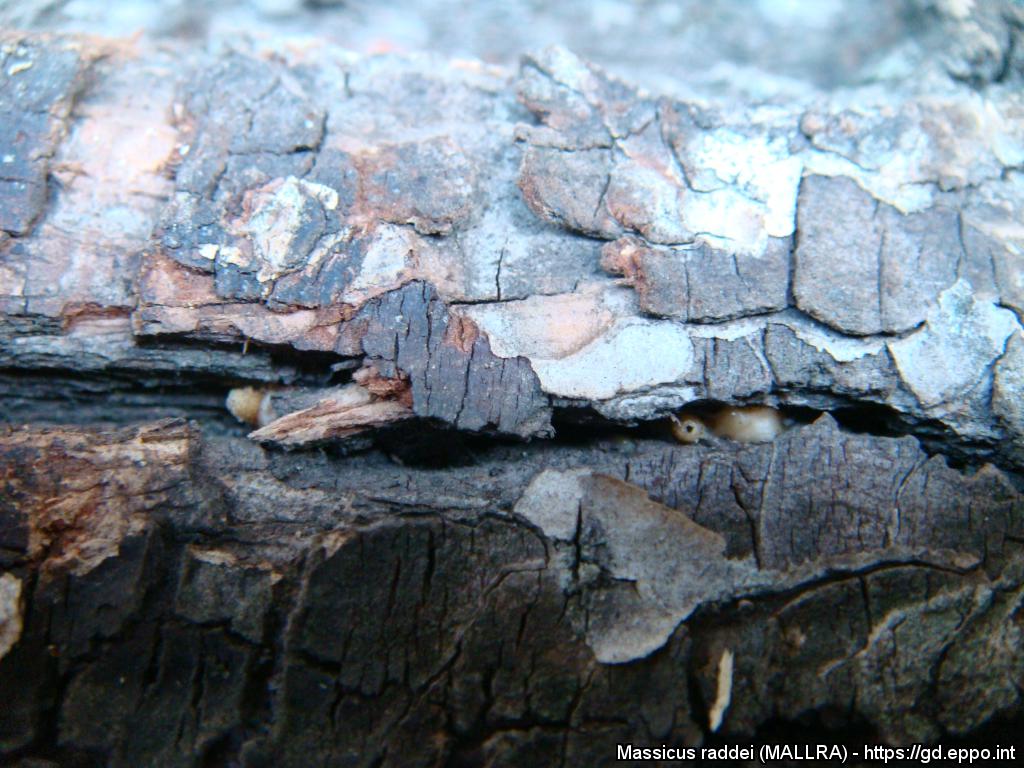Not present in UK
Notifiable – See ‘Report a sighting’ below
Scientific name – Neocerambyx raddei (N. raddei)

Photo © Kirill V. Makarov
Deep mountain longhorn beetle, also known as Oak longhorn beetle (Neocerambyx raddei, previously known as Massicus raddei), is a major pest of Asian oak species such as Quercus mongolica and Quercus liaotungensis. It has also been found to infest Asian chestnut and mulberry species (trees in the genera Castanea and Morus). It is native to East Asia.
There have been no reported discoveries of the pest in the United Kingdom (UK), but we remain vigilant for an accidental introduction. Suspected sightings must be notified immediately to the forestry authorities: see ‘Report a sighting’ below.
Distribution
Deep mountain longhorn beetle is native to East Asia. Its range covering Far East Russia to Northern Vietnam. It has not been reported outside its native range. It is classed as an A1 quarantine pest by the EPPO in the UK and many other countries.
The threat
Deep mountain longhorn beetle is a primary wood borer of trees that are healthy or stressed; its larvae bore into the xylem of host trees, creating large galleries that obstruct the transportation of water and nutrition, thus causing crown dieback or even death.
Assuming native oaks and sweet chestnut trees are hosts, the presence of Deep Mountain Longhorn Beetle in the UK would introduce an additional threat to these trees which are already under pressure from outbreaks such as Acute oak decline, Oak processionary moth (Thaumetopoea processionea), Oriental chestnut gall wasp (Dryocosmus kuriphilus) and Sweet chestnut blight (Cryphonectria parasitica). If native trees are not hosts, this pest still poses a risk to ornamental species grown in the UK. Deep mountain longhorn beetle is not a known vector of pathogens.
Susceptible species
The primary hosts of the deep mountain longhorn beetle are Quercus mongolica and Quercus liaotungensis. Though known hosts of deep mountain longhorn beetle such as Asian oaks (Quercus) and chestnut (Castanea) species are present in the UK as ornamentals and fruit trees, it is expected to be a potential threat to native oak species (Quercus spp.) and sweet chestnut (Castanea sativa).
Identification and symptoms
Adult deep mountain longhorn beetles are between 32 and 57 mm long and can be uniformly black to seemingly dusted brown due to fine hairs on their bodies. They have a distinctly wrinkled texture on their thorax (pronotum). The males’ antennae can be up to twice as long as the females.
Deep mountain longhorn beetles can be mistaken for the endemic lesser capricorn beetle (Cerambyx scopolii) and great longhorn beetle (Cerambyx cerdo), though can be distinguished from the former by being much larger.

Pictured above: Cross-section of N. raddei larval galleries in the xylem. Photo credit: Wang Xioa-Yi (Chinese Academy of Forestry, Neocerambyx raddei (MALLRA)[Photos]| EPPO Global Database)

Pictured above: Pupa and longitudinal galleries. Photo credit: Wang Xioa-Yi (Chinese Academy of Forestry, Neocerambyx raddei (MALLRA)[Photos]| EPPO Global Database)
On standing trees, apart from signs of dieback, the large exit holes are the most notable signs of previous infestation, though these can be mistaken for those of other species. Early signs of infestation are difficult to observe.

Pictured above: Eggs laid in bark crevice. Photo credit: Wang Xioa-Yi (Chinese Academy of Forestry, Neocerambyx raddei (MALLRA)[Photos]| EPPO Global Database)
Frass ejection holes tend to be overlooked before a tree starts showing symptoms of ill-health. The individual eggs covered in white mucus in bark crevices are difficult to find and identify.
Report a sighting
If you believe you have observed a deep mountain longhorn beetle, or signs of its presence in one of the tree species listed above, you must report it immediately.
- Report suspected sightings in Great Britain to us with our TreeAlert online pest reporting tool.
- Report suspected sightings in Northern Ireland to the Irish forestry authorities using TreeCheck, the all-Ireland pest reporting tool.
Note that TreeAlert and TreeCheck both require clear, well lit digital photographs of the pest and/or symptoms of its presence.
Suspected sightings, especially sightings within the plant trade, can also be reported:
- in England or Wales – to the Plant Health & Seeds Inspectorate (PHSI) of the Animal and Plant Health Agency (APHA) on planthealth.info@apha.gov.uk; tel: 0300 1000 313;
- in Scotland – to the Scottish Government on hort.marketing@gov.scot; tel: 0131 244 8923; and
- in Northern Ireland – to the Department of Agriculture, Environment & Rural Affairs (DAERA) on planthealth@daera-ni.gov.uk; tel: 0300 200 7847.
If possible, catch any beetles you find and place them in secure containers such as sealed glass jars so that an inspector can collect them. The beetles are not harmful to people, but they should be handled with caution because they can nip, although the nip is unlikely to penetrate the skin or draw blood. For most people the nip is likely to be no more uncomfortable than a nip by one of our larger native beetles.
Life cycle
In its native range, deep mountain longhorn beetle has a three-to-four-year lifecycle. Adults tend to emerge in July and August, leaving large exit holes on trunks. They survive for around 16 days, feeding on the sap of trunks by biting into the bark. They are most active at night and are strongly attracted to light. Females will lay on average 20 eggs which they lay individually in the crevices of the bark of live trees, and cover with a white mucus.
Early-stage larvae feed under the bark (on the cambium and phloem), whilst in their second year, later stage larvae feed in the heartwood (on the xylem), which is where the pupae develop. An individual ejects frass (a sawdust-like material) though a single hole for the duration on their boring. Galleries are bored horizontally or vertically, but do not go below ground-level or into the roots and have on average a volume of 144 cubic centimetres.
Spread
Whilst not known to be present outside its native range, larvae, pupae and adults may be imported on or in Quercus and Castanea plants and wood from East-Asia.
Regulation
Imported wood products should follow the following guidelines:
- Plant health news issue 42 – May 2021 – GOV.UK (www.gov.uk)
- EU Exit and tree and forestry pests and diseases
- Proposal for a future policy approach: Neocerambyx raddei (Coleoptera: Cerambycidae)
See the UK Government website for guidance on the regulations designed to protect the UK from accidental introductions of plant pests
Official action
The action which would be taken in the event of a discovery of an outbreak of deep mountain longhorn beetle in the UK would aim to eradicate the outbreak. It would be likely to include:
- establishment of a buffer zone around the infested tree or trees;
- a temporary ban on any felling, tree surgery or pruning of trees and shrubs within the zone while a survey is carried out;
- a ban on movements of host plants and wood out of the zone. This would include plants from garden centres;
- a survey of all possible host trees within the zone. The zone would be extended if necessary around other trees found to be infested;
- felling and chipping of infested trees and shrubs and, on the precautionary principle, other nearby host trees. (Experience with Asian longhorn beetle has shown that some trees are likely to be found to be infested only after they have been felled, when they can be more closely inspected than is possible when they are standing.); and
- annual re-surveys of the area for several years afterwards to check for any continuing presence.
